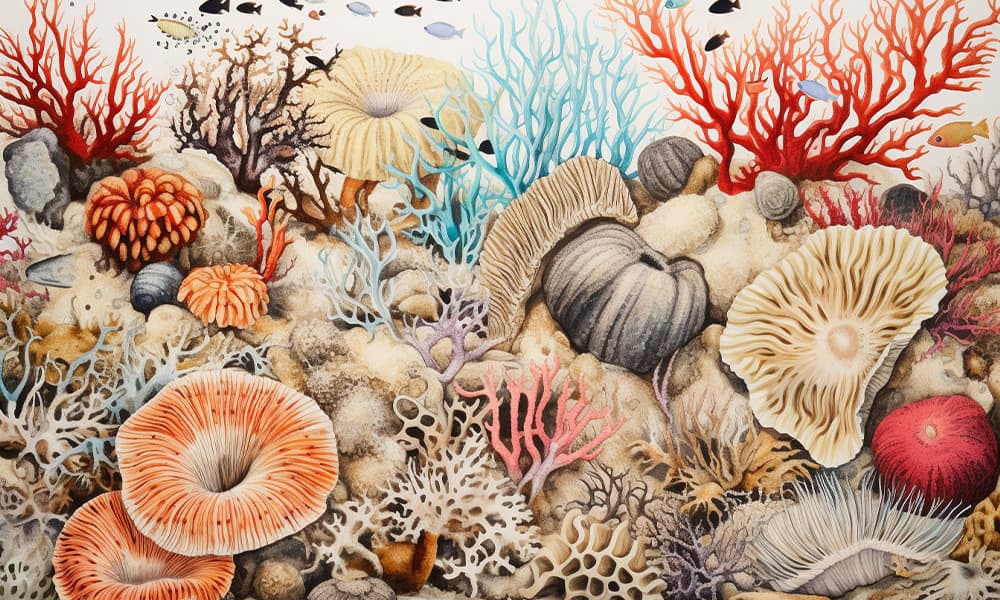Though Costa Rican diving is probably best known for big-animal encounters, divers looking for interesting bottom life will not be disappointed.
While the Caribbean has a greater diversity of reef and bottom-dwelling life, the Pacific has its fair share of animals that make their home on the ocean floor. Corals, urchins, anemones, sea fans, tunicates, starfish, sea cucumbers, sponges, crustaceans, mollusks and more thrill divers here, especially marine photographers.
Many of these little animals look like something perhaps from another planet. Floating above these creatures, many divers often have no idea what they are looking at. At some dive sites, the bottom is so cluttered with myriad different species that you might not even be sure if what you are seeing is a plant, animal or rock. Seen close up in bright light, these strange beasts may be dazzlingly beautiful.
Probably everyone has seen and used a sponge, but not so many see them growing like weeds on the ocean floor. These things blur the line between plant and animal.
They grow in countless shapes, from tiny as your finger to huge barrel sponges big enough for a couple of people to have a bath inside. Enchanting sponges grow on both coasts, but the sponge gardens offshore of the southern Caribbean’s Manzanillo, in the Gandoca-Manzanillo National Wildlife Refuge, are perhaps the most spectacular in the country. There are hectares and hectares of rolling hills of reef covered in an assortment of sponges, including the biggest ones in the country.
Corals and anemones belong to the same group of critters as jellyfish, the cnidarians. Many sting you if touched. Anemones look like fat, tentacled jellyfish attached to the bottom. When seen very close, corals look like little upside-down jellyfish in a tiny cup.
They make the cup themselves with the help of algae that live with each coral. Enough cups and you’ve got a reef. Not all corals make reefs, but the ones that do have changed the world.
Coral reefs are the most diverse marine ecosystems known in Costa Rica and the world, like the rain forests of the land. Like the disappearing rain forests, you might want to see some before they are gone. High temperatures make reef-building corals spit out their alga buddies, turn white and stop growing. If these bleached corals do not get their algae back in time, they die. Bleaching corals have been recorded around the entire Caribbean Sea over the past year, including in Costa Rica.
Many mollusks move around the country’s coasts, and many people like to eat them. Some mollusks, such as clams and oysters, live on or in the bottom. We find the treasured shells of dead mollusks washed up on beaches. Alive, underwater, a shell’s colors are far more vibrant, and the animals inside are often more incredibly colored than the shells.
Annelids are also known as worms, and the ones that grow on corals and rock underwater are often described as beautiful. Their strange shapes and bright colors give rise to names such as “Christmas tree worm” and “feather duster worm.” You must not get too close, move very slow and not block the light, or they disappear into the bottom faster than you can blink.
Arthropods include the insects of the air and the crustaceans of the sea. Indeed, divers often call lobsters “bugs.” Many crustaceans of the sea, such as lobsters, shrimp and crabs, spend part of their life cycles crawling around the bottom. Many are prized on a plate, steamed, boiled, grilled or raw.
Bryozoans, called sea fans, are another group that confuses the meaning of plant or animal. Their colors and shapes light up any reef. Adding flair to life on the bottom are also the echinoderms: brittle stars, starfish, sea cucumbers and urchins. And little bell-shaped tunicates also make bright spots of color on the reef.
All these bottom beasts boggle the mind of divers checking out what’s below Costa Rica’s seas. You can spend days in one little spot and still not see every animal right there in front of you. If you like birding, you will love the bottom.






